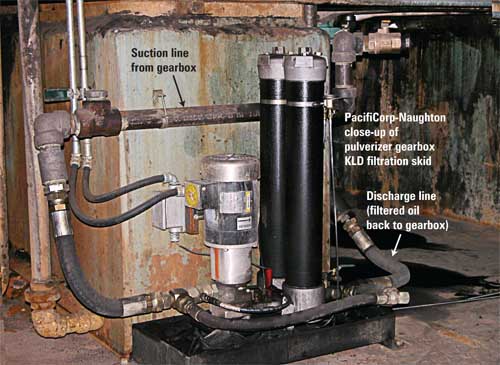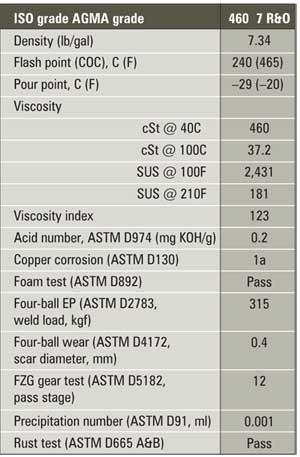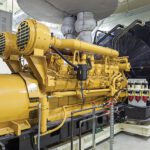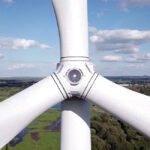A coal-fired power plant operating in the western U.S. was experiencing short gearbox life in its coal-pulverizing operation. After an annual gearbox inspection, oil analysis results indicated that the AGMA 6EP (ISO 320) gear oil recommended by the original equipment manufacturer (OEM) had failed to provide adequate lubrication and protection. This conclusion was based on oil analysis results and gearbox inspection after one year of operation.
After further analyses of the used extreme pressure gear oil, the excessive buildup of particulate contaminants in the lubricant and depletion of the extreme pressure additive package was determined to be responsible for the faulty gear boxes. The particulate contamination consisted primarily of dirt, coal dust, and metallic particulates generated by bearing and gear tooth wear.
Operating Costs
The plant’s pulverizer gearbox design dates back to the early 1960s. It consists of a steel worm gear driven by a large 800-rpm electric motor that drives a bronze bull gear directly connected to a grinding table. The sump holds 255 gallons of lubricating oil. Its temperature is controlled by an integral water-cooled heat exchanger. Unfiltered ISO 320 EP lubricating oil was recommended for lubrication of the bronze-on-steel gears and bearings.
Although the gearbox design is rugged and simple, maintenance costs were becoming excessive, and maintenance outage and overhaul intervals did not support power generation schedules at the plant. Typical maintenance costs and oil change intervals for each pulverizer gearbox were:
-
Oil changed every 12 months at a cost of $5,000 in material and labor and $20,000 to $50,000 in lost electrical production (typical of most coal-fired power generation units of this age).
-
After 10 years of operation, the bronze bull gear was rotated to expose the unworn gear teeth. This required four weeks of turnaround time and included maintenance work at a total cost of $300,000 per unit.
-
After 20 years of operation, a complete rebuilding of the gearbox was required. Parts and labor for this effort exceeded $450,000 per gearbox, with lost production costing another $250,000 per pulverizer.
Breaking the Wear Chain Reaction
Careful preliminary analysis of worn components indicated that the bronze gear face was experiencing significant sliding contact and spalling. Over time the bronze gear face wear became more and more significant. As a consequence, the plant’s personnel began to search for a better lubrication system to break the wear chain reaction.
Staff suspected that the wear patterns on the bronze bull gear faces were attributable to several factors, including high particulate loading of coal dust and dirt in the gear oil and catalytic reactions between the gear oil additives.
In addition, chemical attack of the EP additive package during operation was creating high levels of copper in the gear oil. Oil contamination from copper was most likely due to sulfur-phosphorus EP additive being active on the bronze bull gear.
It quickly became clear that these issues needed to be addressed. Plant personnel sought methods to better seal the gearbox from particulate infiltration, primarily in the form of coal dust. Likewise, great efforts were made to implement filtration methods and options for the lubricating oil to quickly capture particulates and generated wear particulates. An enhanced lubricant technology (both base oil and additive packages) was applied to enable extended maintenance intervals without incurring energy use penalties.
Problem Resolution
After a period of trial and error in which a variety of solutions were tested for effectiveness, success at breaking the wear chain reaction was achieved via controlling particulate ingress. The successful approach involved using breather desiccant filters mounted on the gearbox vents and paying very close attention to the grinding table seals. Initial ISO Cleanliness Code of 23/21/18 (per ISO 4406-1999) was achieved with aggressive breather filtration.
Prior to limiting particulate ingress, employees were unable to establish the target ISO cleanliness level due to the very high levels of particulates. Historically, the ability to filter ISO 320 and 460 gear oils in a coal-pulverization environment had proven very difficult. To address the gear wear issue, plant personnel determined that a kidney loop filtration system would be one of the better options for removing particulate contaminants from the pulverizer gearbox.
However, an effective kidney loop filtration system must have the following characteristics:
-
High dirt-holding capacity.
-
Low maintenance requirements. (Filter changes should not be needed more than monthly under normal operating conditions.)
-
Continued gear oil cleanup and effective maintenance of target Cleanliness Code 18/15/11 per ISO 4406-1999.
-
Pre- and post-filtration sampling points for evaluation of filter effectiveness.
-
Skid-mounting installation.
-
Suction and discharge locations designed to eliminate fire hazards and a turnover of the entire gearbox oil sump every 30 minutes.
-
Filtration skid size that does not interfere with normal maintenance activities.
Advances in Filtration Technology
Advanced filtration technology that would meet the requirements for this application was determined to be readily available for heavy gear oil. An off-line kidney loop filtration package using a high-efficiency, high – dirt holding capacity, synthetic filter media was installed. It uses two filter housings mounted in series with a common sized element in both housings (see figure).

Kidney loop filtration system. Courtesy: Schroeder Industries
The filter elements initially recommended for the trial installation were rated at beta 25 = 200 in the first stage and beta10 = 200 in the second stage. Oil flow was delivered by a vane pump rated at 10 gpm for a 460 cSt (2,500 SUS) gear oil. Temperature ranges of the system fluid varied from a low of 65F (18C) when idle up to 130F (54C) during normal operation. The filtration package was installed with the suction line coming into the filter bank directly from the bottom of the reservoir and the outlet or filtered discharge line. It is piped directly into the top of the reservoir.
Currently, the filter element condition is monitored by differential pressure gauges installed on each filter’s housing. During normal operation the target is to keep the differential pressure across the filter between 25 to 28 psig. Other features of the filtration package include upstream and downstream sampling valves. These allow lubricating oil samples to be taken without having to shut down the system.
Advances in Lubrication Technology
During the system update, it was recommended that an AGMA 6EP (ISO 320) lubricating oil for pulverizer gearbox be included in the system design. Evaluation of the wear patterns on the gear teeth indicated that the EP additive package in this lubricating oil was too active on the bronze bull gear. This, in conjunction with the contaminants in the gearbox, was causing premature wear and failing to provide adequate protection for the gears.
Analysis of used gears’ lubricating oil samples confirmed that the EP additive package was being depleted by extended contact between the steel-on-bronze gear face and sliding wear. Infrared thermographic imagery indicated that this extended contact between the two materials resulted in higher gear face temperatures. Very high dirt and particulate loading was confirmed by the ISO Cleanliness Code.
After consulting with the lubricant supplier, it was determined by all parties that AGMA 7 R&O (ISO 460) synthetic gear oil would best protect the gearbox in this application. The higher viscosity grade and improved lubricity of this synthetic gear oil, coupled with R&O additive chemistry, was able to provide higher oil film strength than that recommended by the OEM. As a result, synthetic oil would extend the life of the gearbox, taking into account the temperature requirements and gearbox longevity. The physical properties of the synthetic gear oil are shown in the table.

Physical properties of ISO 460 synthetic gear oil. Source: Schroeder Industries
In the past, plant personnel considered the feasibility of using synthetic gear oil in the pulverizer gearbox but determined that the high dirt loading in the gearbox made using synthetic oil uneconomical because of frequent oil changes. However, because recent filtration improvements have resulted in a potential oil life of at least three years, the economics of using synthetic gear oil could be justified. The synthetic ISO 460 R&O gear oil offered several benefits, including:
-
Enhanced filterability and pumping at lower temperatures.
-
Higher oxidation resistance and thermal stability.
-
Higher film strength at high and low temperatures.
-
Extended service life in a clean, filtered environment.
Operational Results
Prior to putting the pulverizer back into service, the gearbox was overhauled and, except for the steel/worm gears, all major rotating components were replaced. The steel worm and bronze bull gears were precision-aligned and blue-checked. In addition, the reservoir was flushed with an ISO 460 mineral oil and filled with the synthetic ISO 460 gear oil.
A baseline gear oil sample was drawn from the reservoir and analyzed for particle count per ISO 4406-1999, with ISO Cleanliness Code results coming in at 23/21/18. Finally, the pulverizer gearbox was put into service along with the filtration system. Following three hours of run time, the particle count was reduced to 21/19/11.
After 48 hours of run time, the plant installed a set of beta 5 = 200 filter elements to further reduce system contamination in each housing. This also achieved target ISO Cleanliness Code 18/15/11 more quickly. The pulverizer gearbox and filtration system continued to run for another two weeks with element condition being monitored using differential pressure gauges. As a result of using the 5-micron media during these two weeks, the target ISO Cleanliness Code 18/15/11 was reached.
Filter element service life was also monitored during the trial installation. Given the initial cleanup of the system, the results showed that the high dirt capacity media exceeded expectations. The actual service life has exceeded expectations. During the trial installation, oil samples were taken and analyzed for physical and chemical properties, particle count, and analytical ferrography. The results showed the wear metals were reduced significantly and the oil cleanliness was maintained.
The End Result
Given the success of this initial installation, the power plant continues to reap the following benefits by using the ISO 460 R&O synthetic gear oil and a new filtration system:
-
Improved gear and bearing lubrication.
-
Minimal to nonexistent wear metals in the gearbox, based on the oil analysis reports.
-
No increase in drive motor energy consumption. (Some plant instrumentation measurements indicated a 1% drop in motor amperage with 4160 VAC motors.)
-
Accurate predictive/proactive maintenance using particle count and analytical ferrography.
-
Significantly extended gearbox life.
-
Eliminated contamination related downtime.
-
Extended maintenance intervals.
By extending the life of the lubricating oil, this plant has reduced the disposal costs and environmental impact of the waste oil. In the fall of 2005 the plant upgraded a second pulverizer with synthetic oil and a filtration system.










